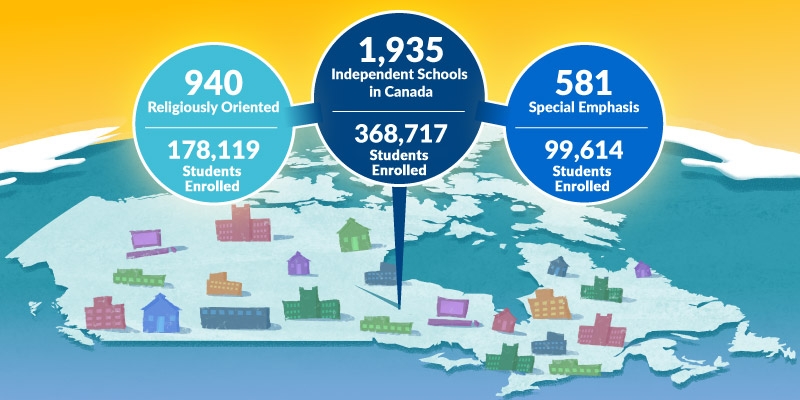A Diverse Landscape: Independent Schools in Canada

This study is the first of its kind to offer a national survey of independent schools in Canada. It seeks to address the persistent myth that independent schools are of one dominant type serving a single sort of family. Contrary to the common caricature that they are enclaves for the urban elite, independent schools parents come in a wide variety of types and serve many educational preferences. They address diverse religious preferences, pedagogical variations, and special needs.
Using school-level data from each provincial ministry of education, this study builds a national picture of the variety of independent schools in Canada.
Although a recent study found that the share of students enrolled in independent schools in Canada is increasing while the share enrolled in government schools is in decline (Van Pelt et al., 2015), it did not examine enrolments in different types of independent schools.
In 2013/14, Canada’s ten provinces were home to 1,935 independent schools. They enrolled 368,717 students from Kindergarten to Grade 12, equivalent to 6.8 percent of total enrolments in independent and government schools in Canada’s ten provinces. Their enrolment distribution roughly matched the population distribution across the country, as a third attended independent schools in Quebec (33.4 percent), almost a third in Ontario (31.4 percent), a fifth (20.4 percent) in British Columbia, and 7.6 percent in Alberta.
Although Canada is overwhelmingly an urban society (over 80 percent of the population lives in urban areas), 37.1 percent of all independent schools were located outside of large urban areas. 22.1 percent were in rural areas and 15 percent in small or medium-sized centres.
Almost half (48.6 percent) of independent schools in Canada had a religious orientation. Almost a third of all independent schools were Christian non-Catholic (30.1 percent), 8.4 percent were Catholic, 4.9 percent Islamic, and 4.5 percent Jewish. Together, religious independent schools enrolled 48.3 percent of all independent school students. Of these 178,119 students, 45.2 percent attended Christian non-Catholic schools, 31.6 percent independent Catholic schools, 10.8 percent Jewish schools, 9.1 Islamic schools, and 3.3 percent attended schools defined by other religions.
A total of 581 schools (30 percent of independent schools) were classified as specialty schools. These declared a special emphasis in the curriculum (e.g., arts, athletics, language, or science/technology/engineering/math), distinct approaches to teaching and learning (e.g., Montessori or Waldorf), or an emphasis on serving specific student populations (e.g., students with special needs or distributed learners). In 2013/14, specialty schools enrolled 27 percent of all independent school students in Canada (99,614 students).
Rigid typecasting of independent schools is more myth than reality. In Canada, the lingering stereotypes are not reflective of the landscape.
Perhaps surprisingly, independent schools most evidently matching the stereotypical image of the traditional type of private school are considerably less common than might be anticipated. When membership in the Canadian Accredited Independent Schools was used as a proxy for such schools, they constituted only 90 independent schools (4.7 percent) and enrolled just 12.1 percent of all students attending independent schools in 2013/14.
In terms of grade-level variation, approximately two-fifths of all independent schools were elementary-only (44.3 percent), two-fifths (37.3 percent) secondary-only, and a fifth (18.4 percent) combined elementary and secondary grades.
In terms of variation in school size, while 65 percent of independent schools had fewer than 150 students, almost half of independent school students (47.2 percent) attended schools with over 500 students.
The funding status of independent schools varies across Canada, in accordance with whether the province offers partial government funding for independent schools (as is the case in five of the provinces). In all, at least 60.6 percent of independent schools in Canada receive no government funding. Considered another way, government funding is not received for at least 41.4 percent of all students enrolled in independent schools in Canada.
The evidence examined in this study leads to a clear finding. Rigid typecasting of independent schools is more myth than reality. In Canada, the lingering stereotypes are not reflective of the landscape. Independent schools are diverse in their religious orientations and their academic emphases. A disproportionate number are located outside of urban centres. They span a diversity of sizes and grade levels. Their funding statuses vary, even in the five provinces where the provincial governments offer some support.
In all, the parents of over 368,000 students—one of every fifteen students in Canada—are sending their children to one of the 1,935 independent, non-government schools in the country, and the picture is clear. They are choosing schools that differ in many ways from one another, the vast majority of which do not conform to the prevailing caricature that private schools in Canada are exclusive enclaves serving only the wealthy urban elite.
Authors:
More from this study
Subscribe to the Fraser Institute
Get the latest news from the Fraser Institute on the latest research studies, news and events.




